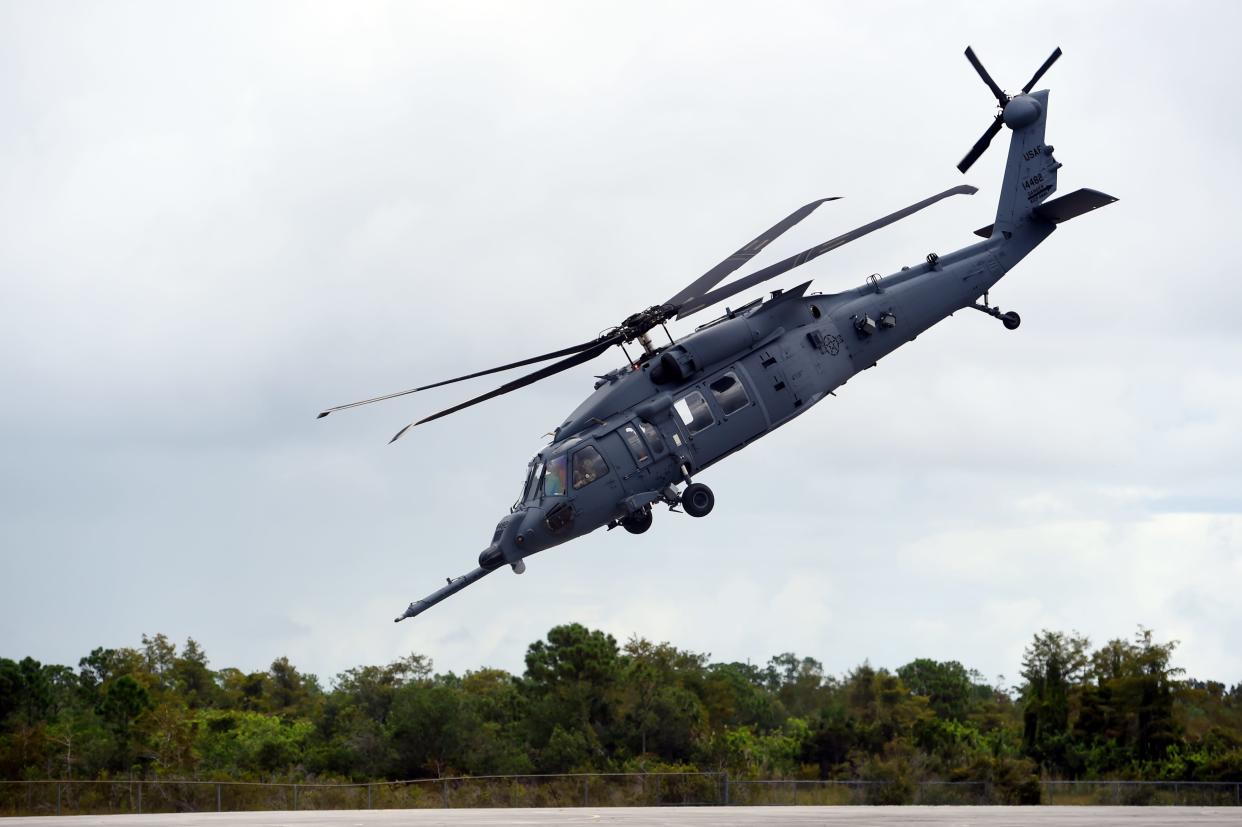Air Force unveils next-gen 'Whiskey' helicopters to replace Pave Hawks: 'A beacon of hope'

JUPITER, Fla. — In summer 2005, HH-60G Pave Hawks with the Air Force Reserve's 920th Rescue Wing flew a daring mission along Afghanistan's Hindu Kush mountains to save Navy SEAL Marcus Luttrell after his team was killed in a Taliban ambush.
Those aging combat rescue helicopters from Operation Red Wings — later memorialized in the book and movie "Lone Survivor" — debuted back in 1982.
Now, the replacement of the Pave Hawk has arrived.
Officials with Sikorsky, a Lockheed Martin company, showcased the next-generation HH-60W "Whiskey" helicopter during a ceremony Monday at the Sikorsky Development Flight Center in Jupiter, Florida.
"You think about the mission that this has to go out there and perform: the altitude, the attacks that it takes from the ground, the folks that it has to take to put on board and carry out of those places — out of those hellholes, literally," U.S. Rep. Brian Mast told the crowd.
"It's never an inherently safe mission. The combat search-and-rescue mission is always inherently dangerous. It's always going into an inherently hot place," Mast said.
Concerns raised about Trump resort: Air Force to review international travel expenses
The Air Force has ordered 113 of the new helicopters, which are based on the UH-60M Black Hawk. They will handle search-and-rescue and personnel recovery operations for all U.S. military services.
Four HH-60W aircraft are undergoing testing and five more are in production, said Frank St. John, Lockheed Martin executive vice president of rotary and mission systems.
Next year, St. John said 200 Air Force maintenance-air crew students at the Sikorsky Training Academy in Stuart will utilize three newly built HH-60W aircraft.
'Sound of freedom'
More than 90% of the HH-60G Pave Hawk fleet has sustained combat damage and/or structural fatigue during the past 30-plus years of service, said Gen. James Holmes. He commands Air Combat Command at Joint Base Langley-Eustis in Hampton, Virginia.
Based at Patrick Air Force Base between Satellite Beach and Cocoa Beach, the 920th Rescue Wing is the Air Force Reserve’s only combat search-and-rescue unit, saving nearly 4,000 lives since 1956. The wing has employed Pave Hawks and HC-130P/N Kings around the globe the past two years:
In July 2017, airmen rescued a German father and son whose vessel caught fire in the Atlantic Ocean roughly 500 nautical miles east of Cape Canaveral.
The next month, airmen flew search-and-rescue missions over flood-stricken Texas neighborhoods after Hurricane Harvey dumped record-shattering rainfall across the Houston area. The wing rescued 235 people, 21 dogs and five cats.
Saturday, more than 100 reservists with the 920th deployed to the Middle East and the Horn of Africa.
"We talk a lot at Air Combat Command about jet noise being the sound of freedom. And it certainly is," Holmes said.
"But when you're stranded, or surrounded, or isolated and you hear the sound of that chopper whipping through the air, that's the sound of freedom that you'll never forget," he said.
NTSB report: Fatal NYC helicopter crash video shows passengers struggling
Next-generation aircraft
It could take four or five years before the first new helicopters arrive at Patrick AFB, said Col. Kurt Matthews, 920th Rescue Wing commander. He said the first factory models will go to active-duty Air Force installations, while Air National Guard and Air Force Reserve units will receive helicopters later.
What's more, Matthews said the 920th Rescue Wing will start receiving C-130J Super Hercules fixed-wing aircraft in February to replace today's HC-130P/N Kings. Commonly seen in the Space Coast skies — and used to refuel Pave Hawks in flight — those aircraft debuted in 1964.
"It's a very proud moment — and kind of sad to say goodbye to a legacy aircraft and platform, whether it's the King or the HH-60G Pave Hawk. But they're being replaced by aircraft that are doing the same mission. So, our mission and our heritage carry over," Matthews said.
"And now, we're going to be doing it in the latest-and-greatest technology," he said.
Matthews assumed command of the 920th Rescue Wing in December 2016.
"My tour is coming to an end. But it's really been about transitioning the wing, modernizing the wing, to be able to shepherd in these new air frames and sustain our mission into the future," Matthews said.
Behind the scenes: Dover Air Force Base — where casualties of America's wars come home
Improved flight specs
Steven "Elroy" Colby flew HH-60G Pave Hawks during most of his career as an Air Force helicopter pilot from 1988-2007, logging various combat tours. He is now a Sikorsky business development principal.
Compared with the Pave Hawks, Colby said the Whiskey model's main fuel tanks have increased from 360 gallons to 660 gallons, nearly doubling the aircraft's operating range.
"The biggest lament about the Pave Hawk historically is, 'I'm relatively short-legged. I'm about an hour out and an hour back.' Now, I'm at least two hours out and two hours back. So that really improves your logistical supportability," Colby said.
Other upgrades include composite rotor blades; engines that crank out 225 more horsepower; a redesigned exhaust system; and a revamped communications system — "the aircraft is essentially an antenna farm," Colby said.
"The insides of these shiny new helicopters will see a lot in the coming years. They'll see wounded children and wounded troops. They'll see flood victims joyfully escaping their fate. They'll see people in the best moment of their lives — and in the worst," Holmes told the audience.
"But they will always, unceasingly, see our rescue teams — the airmen that will make this airplane work — selflessly, heroically doing everything in their power to save those who could not save themselves," he said.
"And provide a beacon of hope to those on the ground."
This article originally appeared on Florida Today: Air Force unveils HH-60W 'Whiskey' helicopters to replace Pave Hawks

